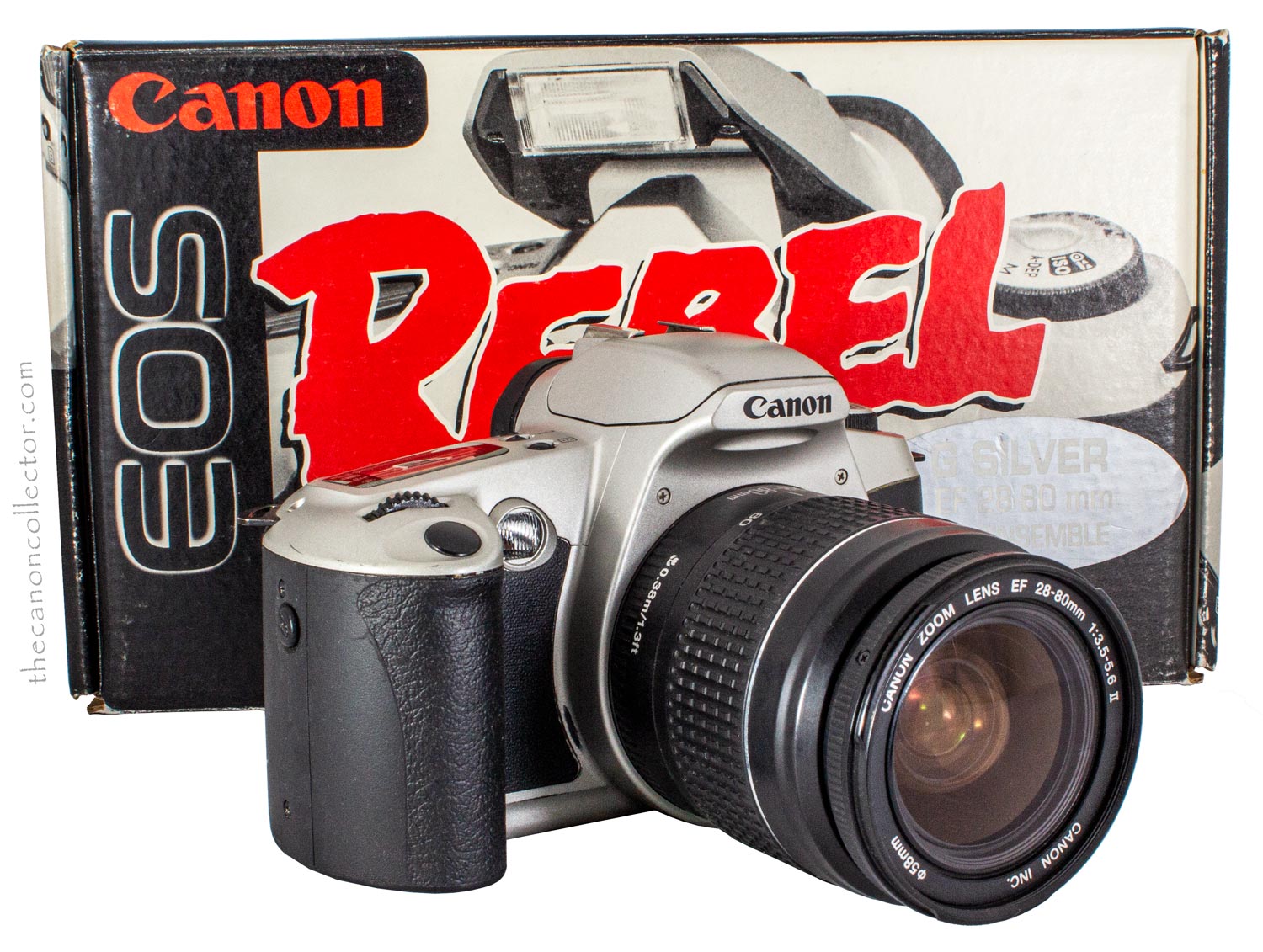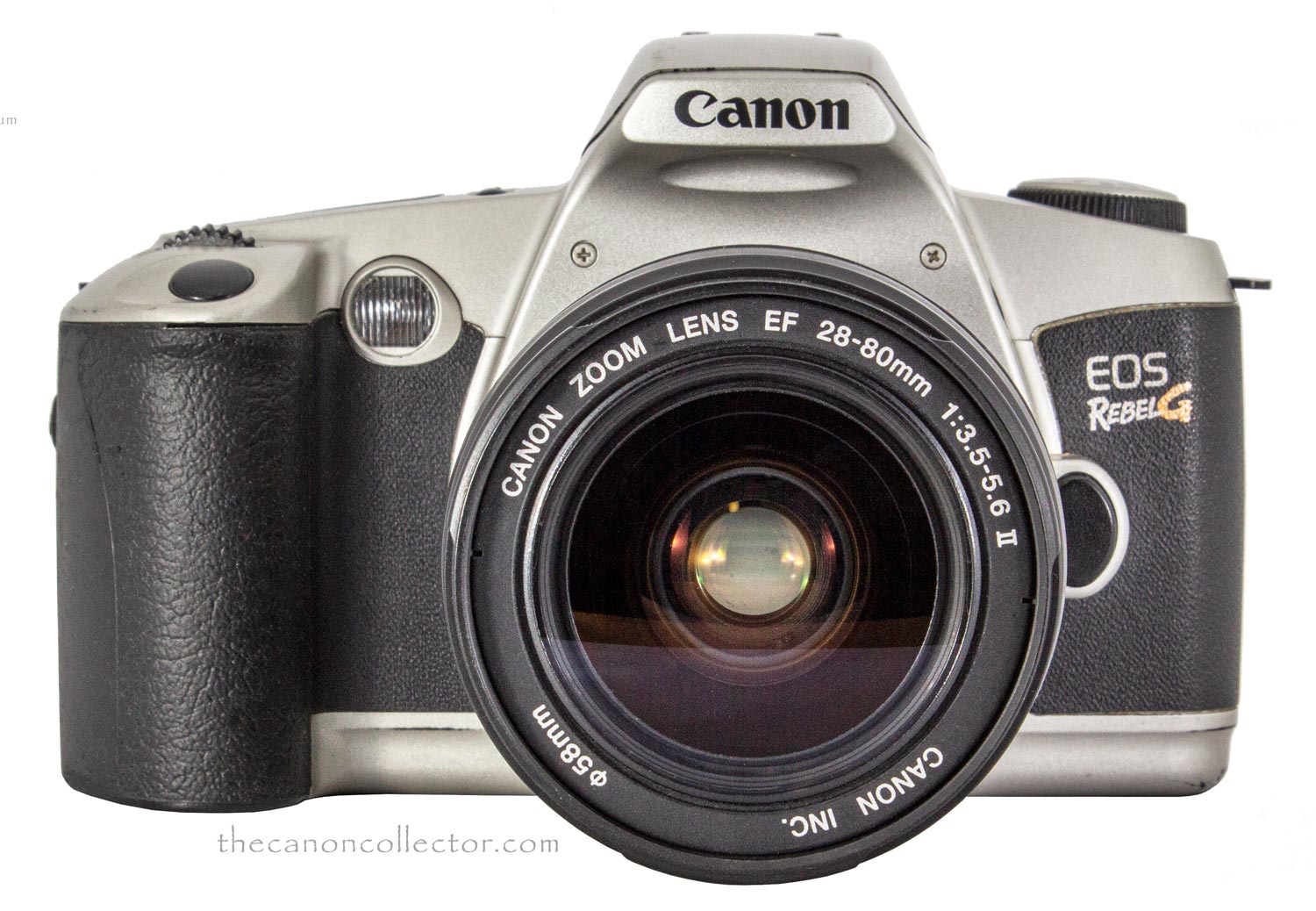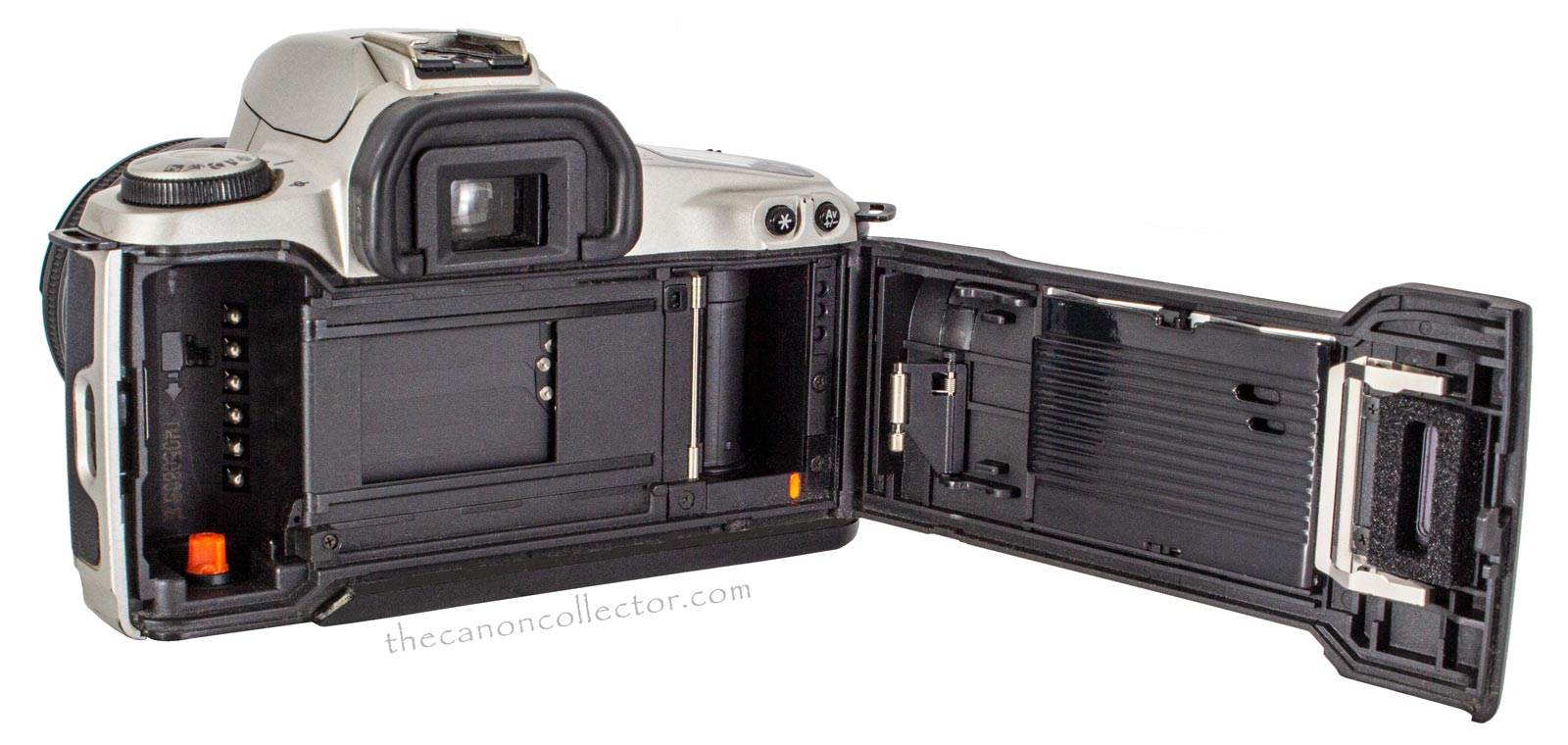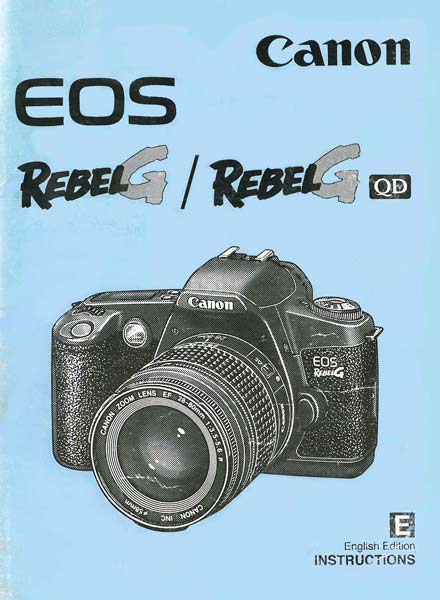This is the EOS Rebel G with the EF 28-80mm kit lens in front of the box they came in. This camera was available in a silver/black finsih and in an all black finish.
The Rebel G body is made of tough plastic throughout including the lens mount. This makes it so light that you forget it is on a strap over your shoulder.
EOS Rebel G
In Europe the 500N and Japan the New Kiss
I have several Rebel G cameras and find
them to be great film cameras. I have had
some of my cameras on my trade table at
local camera shows and I find it difficlut
to give these cameras away, much less ask money for them. And yet, this is a really
good camera for shooting film.
Shown on the left is the Rebel G with one of usual kit lens, the EF 28-80mm 1:3.5-5.6 II zoom lens. This is essentially the EF-S 18-55mm lens
that came standard on APSC sensor digital
cameras more recently. It looks the same
and is about the same size.
I think maybe people pick up this camera and it is so light that they dismiss it out of hand. It is light but it is accomplished as well. This camera is capable of really fine photography and the the bonus is that it will accept all of the Canon line of EF lenses, even all of the ones designed for digital. You can mount really superb glass
on it.
This EOS Rebel G was sold internationally
as the EOS 500N and in Japan as the
EOS New Kiss.
There are three focus points across the viewfinder screen which are selected automatically in the auto modes and are user selectable via the LCD screen on the top of the camera in any of the manual modes.
Several picture taking modes are selectable via the Command Dial on the top of the camera. As well as the automatic modes for the entry level photographer the camera can also be operated in Aperture
Priority, Shutter Priority or Manual modes. As a result the camera is capable of
very creative photography.
This is the EOS Rebel G with the EF 28-80mm kit lens in front of the box they came in. This camera was available in a silver/black finsih and in an all black finish.
This is the EOS Rebel G with the EF 28-80mm kit lens in front of the box they came in. This camera was available in a silver/black finsih and in an all black finish.
Inside there is nothing surprising. On the left where you put the 135 cartridge you can see the metal contacts that read the DX codes off the can. ISO is set automatically but this can be overiden by setting it manually. The shutter travels vertically with speeds from 30
seconds to 1/2000th of a second. The film pressure plate has two holes
in it, upper right corner, because the camera was available
in a version that recorded date and time on the film. But
pressure plates were all the same.
The Rebel G also came in a black model which I think looks better. This picture is from Ken Rockwell’s excellent web site. Check out his write up on this camera.
Construction is all
plastic even down to the lens
mount. Instead of a pentaprism it
uses a mirror prism which is much lighter.
In use, the Rebel G first winds the film to the end, and then shoots the frames in reverse order, exposed frames being wound back into the canister as they are exposed. Its frame counter always shows you the frames remaining as it counts backwards.
The Rebel G was an inexpensive film camera. Its advantage is that it weighs nothing and works great. It shoots in all exposure modes and has a modern evaluative metering system.
This camera was succeeded by the EOS Rebel 2000 in 1999.
Accessories available included a grip (GR-80TP), eyepiece extender (EP-EX15), E Diopters, dedicated cable release (RS-60E3), external battery pack (BP-8), and camera cases (EH8-L and EH-8LL).
You can get into all of the features of this camera by reading the User Instructions. Click on the cover on the left to open the manual.
Now, one more plug for this camera. The Rebel G is a great camera for a beginner in film photography because it is simple to use but is capable of taking excellent pictures. They are available in the second hand market at very reasonable prices.
So how does it Shoot?
Preparing to write this page I took one of my Rebel G’s out for a walk and shot a roll of film. The first thing I noticed was that when you load the film the whole cassette wound out and the camera counted the images available. I cut an odd length of film but the camera still counted the correct number of exposures available. As I took pictures the counter counted down always indicating the number of shots remaining.
The film advanced automatically after each shot so quickly that you were almost not aware of it. With each exposure the exposed frame wound into the cassette so that even if you accidentally opened the back of the
camera, your images would be safe. Only the unexposed film would be ruined.
The film cassette had a DX code but it was incorrect because I had reloaded the cassette with different film. I was able to set the film speed manually to the correct setting. In the viewfinder are three inscribed squares indicating focus points. The camera choses one automatically in the auto modes but in M, Av, and Tv the user can select any one of them. The one selected is shown on the LCD on the top deck.
When I took the camera out of my camera bag the rubber eyecup immediately fell off! This is a problem with all of the eraly EOS cameras, the eyecup clips that hold the eyecup in place break. As a result many of these cameras are found without eyecups. The fix for a loose eyecup is to place a single layer of masking tape, not too big, on each side of the viewfinder lens and when the eyecup slides on it will bind in the tape and stick in place.
Focus with the EF 28 – 80mm f/3.5-5.6 was not as fast as my 5D Mk II or Canon R but it was quick and positive. The two stage shutter button was not as crisp as I am used to but it did not take long to get used to it.
I used the Auto setting throughout and the film, when developed, was correctly exposed in every frame. And they were all uniform. The metering was very accurate. From that roll of Ilford HP5 I have chosen four images. All but the picture of Susan are from the full frame. The image of Susan is about 75% of the frame. Unfortunately, with that one, I was not as careful with composition as I should have been and had to do some cropping to correct it.
This roll of pictures was taken on a walk I took with my wife Susan. Along the way she posed for me on a large boulder probably left over from the last Ice Age.
I was using Ilford HP5 and shooting it at ISO 400 so, although the day was mixed sun and cloud, the film speed allowed the camera lots of latitude in the settings it chose. All of these images were taken with the settings the camera chose on Auto mode. I also let the camera select the focu point on its own. As you can see, the Rebel G did a very nice job.
I did not record the camera settings the camera choose and being a film camera there is no metadata file to go back and refer to. But I certainly have no complaints with the results.
These images were scanned from the film using a Canon 9000F Mk II flatbed scanner set to 2400 dpi. I get much better digital images using my Canon R to photograph the negatives but for web pages such as this the flatbed scanner works well enough.
Here in Vancouver we call the bridge span in the center the Second Narrows or Iron Workers Memorial Bridge. On the right edge is a parallel railroad bridge across the Burrard Inlet.
There are things I like to photograph, like clouds and flowers. Another is anything with sharp form and contrast like these tree branches.
Very near our home is a park along the bluffs over the ocean where we walk frequently. In this image it is a little barren being in the middle of February.
This website is the work of R. Flynn Marr who is solely responsible for its contents which are subject to his claim of copyright. User Manuals, Brochures and Advertising Materials of Canon and other manufacturers available on this site are subject to the copyright claims and are the property of Canon and other manufacturers and they are offered here for personal use only.












